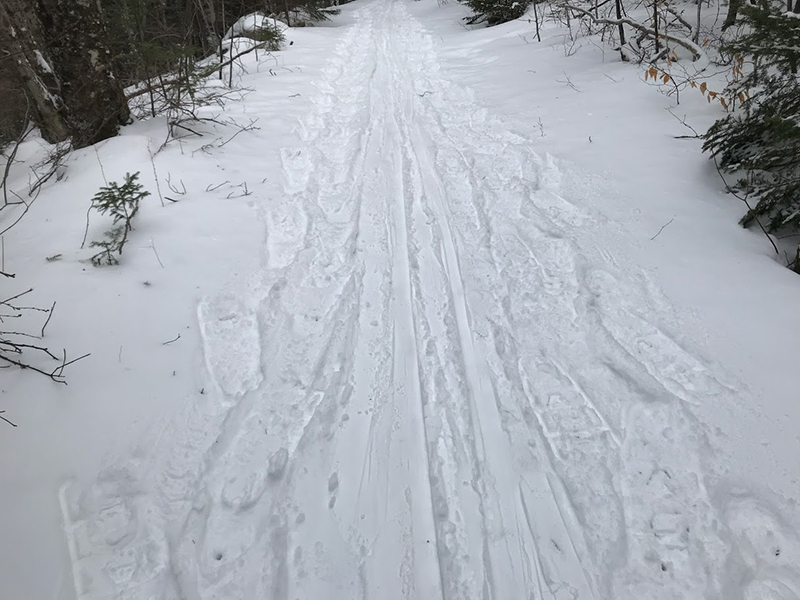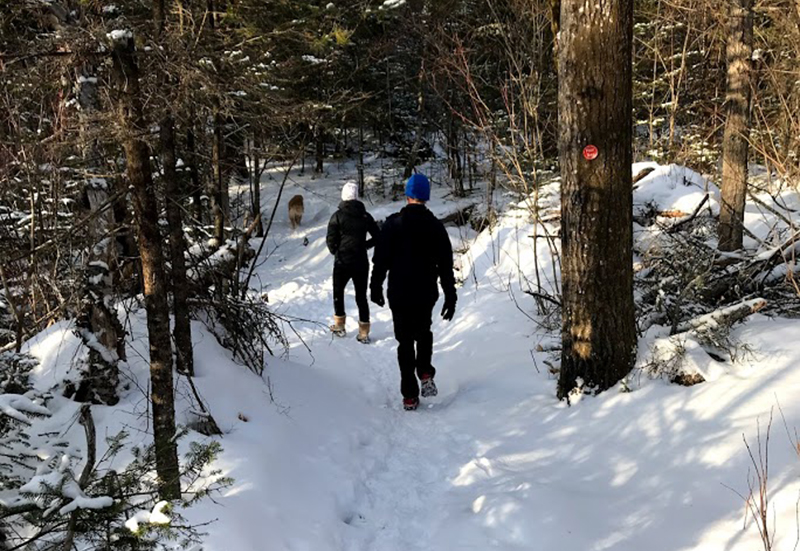
Winter is for Skiing | Postholing in the Adirondacks
By: Diane Fish - Adirondack Council Deputy Director
Thursday, February 22, 2018
Getting outside and enjoying the snow and crisp air is a highlight of being in the Adirondacks in the winter. The Jackrabbit cross country ski trail that winds its way through the Forest Preserve and across the properties of generous landowners between Keene and Paul Smiths offers up skiing opportunities for those of all abilities. Maintained each summer and fall by a crew of volunteers organized by the Barkeater Trail Alliance (BETA), the trail is a labor of love that greatly enhances the quality of life for many in the Tri-Lakes region during the winter months. Other Wilderness ski trails in the area (Whiteface Landing, Avalanche Lake) together with groomed trails at Cascade Ski Touring Center, Mt. Van Hoevenberg and Dewey Mountain make the Tri-Lakes a great place to be a cross-country skier.

For those who love to cross-country ski, the season in the Adirondacks is too short. We seize every opportunity to feel the skis gliding across the snow, experience the quiet of the woods, and take in the beauty of a snowy trail.
That’s why encountering people walking in the ski trails – in the Wilderness and even at the groomed cross-country ski centers – is a point of aggravation. Hours of work have gone into preparing trails for skiing and there are only a few months when conditions are right (if we’re lucky). People stomping on the trails are likely unaware that their behavior shows incredible disregard for trail volunteers and the community of cross-country skiers that wait all year long for the opportunity to strap on the skis and glide through the woods. There are signs at many trailheads announcing that walkers must stay to the side of the trail (if they must walk) and in some places stating that snowshoes or skis are required. But, too often the signs are ignored. Walkers make a judgement that they are safe and adequately equipped, not understanding that their walking is a problem for others. Snowshoe tracks to the sides of the ski track on the Jackrabbit/Old Mountain Rd. ski trail.
Snowshoe tracks to the sides of the ski track on the Jackrabbit/Old Mountain Rd. ski trail.
Really? Yes, really.
Walking in boots (with or without micro-spikes), even on packed trails, damages the trail for skiing by impairing the function of the ski. A ski needs to make firm contact with the snow to provide the “kick” that propels the skier forward. Trails that are walked on are lumpy so the ski makes only partial and inconsistent contact with the snow. In addition, a track – either set by a groomer or skied in over time - helps guide the ski in a straight line. In deep snow, walking on trails and leaving deep footprints or “post-holing” not only impairs the ski function, but creates a situation that is dangerous for skiers. A tip of the ski caught in a post-hole could lead to a fall and injury.
 Hikers walking in the ski tracks on the Lake Rd. in Keene Valley
Hikers walking in the ski tracks on the Lake Rd. in Keene Valley
The Golden Rule: Don’t Walk in Ski Trails
While it’s important to read the signs and follow the rules, it’s also important for winter trail users to understand that there are universally accepted winter trail ethics. The golden rule: don’t walk in ski trails. If you must walk, stay to the side of the trail. Hiking with snowshoes is better since the snowshoe leaves a relatively flat “footprint,” but in general snowshoers should also avoid walking in ski tracks.
It’s Unsafe for you and Other Hikers
The NYSDEC says, “Snowshoes or skis are required in the High Peaks Wilderness wherever snow depths exceed eight inches. The use of snowshoes prevents “post-holing” (leaving deep footprints in the snow), avoids injuries, and eases travel on snow-covered trails. Post-holing makes trails more difficult and more hazardous for others to use.” You may not get a ticket if you stomp in ski trails, but you should not be surprised if a kindly cross-country skier gives you a quick lecture (or a firm reprimand). Walking on a ski trail shows disregard for volunteers and fellow trail users. It’s just not nice.
During early and late winter when temperatures fluctuate and trails are muddy, wearing improper footwear can cause damage to other hikers and the trails. Visit Adirondacks says, “Avoid trails with soft snow cover to limit environmental damage and "post-holing," which can lead to leg and ankle injuries.”
There are plenty of trails that remain primarily for walking even during the winter months. Even if these trails are used by skiers, their proximity to the village center, shorter mileage, and heavy use as walking trails during other seasons, make it logical that skiers should defer to walkers in these locations. The trails at Henry’s Woods and Heaven Hill in Lake Placid are good examples.
 Walking on the trail to Big Crow. A little snow over solid ice on a twisty trail makes this a suitable
Walking on the trail to Big Crow. A little snow over solid ice on a twisty trail makes this a suitable
trail for walking and snowshoeing and not good for skiing.
In an effort to reduce user conflicts, a system of labeling trails that indicates a primary activity could clarify the priority use along. This labeling along with a summary of trail ethics could help everyone share the trails more amiably and get the most out of our too-short season for winter recreating.
 Diane joined the Council staff in 2001 and works with the Board and Staff to raise the financial resources needed to support the Council's conservation and advocacy efforts on behalf of the Park. An important step in this process is keeping in touch with supporters in all 50 states to understand their interests and concerns about the Adirondack Park and to engage members in the Council’s advocacy efforts.
Diane joined the Council staff in 2001 and works with the Board and Staff to raise the financial resources needed to support the Council's conservation and advocacy efforts on behalf of the Park. An important step in this process is keeping in touch with supporters in all 50 states to understand their interests and concerns about the Adirondack Park and to engage members in the Council’s advocacy efforts.
Diane shares other Council supporters' love of the Adirondacks, enjoys the Park's many outdoor recreation activities, and appreciates the astounding beauty of the Park every day.




